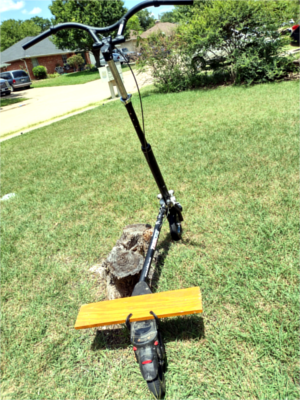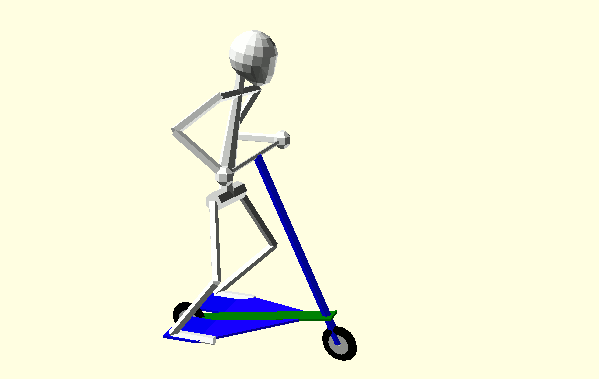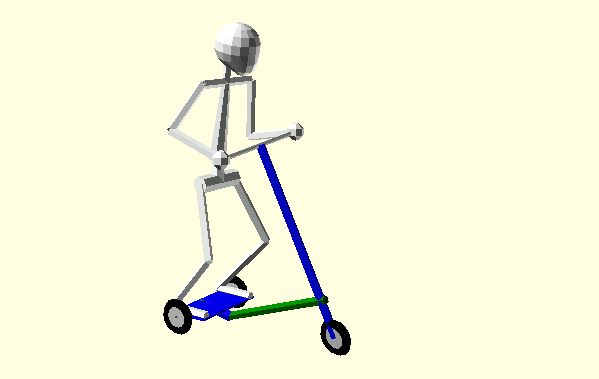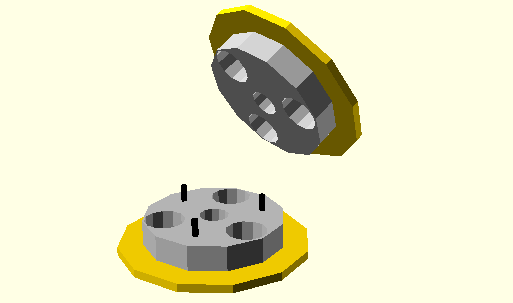Picture 1: A "half-Trikke" with a wing

The ingenious design of Trikketm carving vehicles capitalizes on synergistic mechanisms that not only make corotation possible, but efficient and comfortable for the rider. Three wheels joined by a special cambering joint create positive stability and wheel-face-angle and foot-deck-angle synchronization. This complex joint and its two arms leading to the back wheels require precision machining and detail, not to mention the complexities of the folding mechanism. Herein the author conceptually simplifies the 3-wheel vehicle and introduces a two-wheel version without any special joints. These designs also allow for a kickstand by which a rider can park the vehicle upright or exercise on a rainy day or a newbie can learn the "dance" before arriving at the trail.
Knowing the [Physics] of Trikke [Corotation] [Video 1] allows simplification of the vehicle implementation. Mostly this information helps us understand what is not necessary for a good ride. Corotation of the vehicle via the rider's body spin consists of two phases repeated to each side of alternating turns.
The rider is now "wound up" to begin the two phases again spinning and turning in the opposite direction; reflecting then transferring body spin to the vehicle.
To corotate comfortably, a vehicle must incorporate the following characteristics:
"CoroWing" or "The Wing" is simply an adult kick-scooter outfitted for more comfortable corotation. "More comfortable"? Yes. It is possible to corotate not only scouters, but bicycles [CarveABike] and traditional trikes. Each has its obstacles to coroting comfortably like seats, and foot placement. Some racing cyclists may unknowingly corotate at the end of a close race, sprint-standing and cambering to the finish. As they rotate hips and shoulders, they realize a speed boost even as they peddle.
Outfitting an appropriate scooter for comfortable corotation at simplest involves clamping a board across the deck close to the back wheel. My board was about 18-inches long and 6-inches wide. On July 25, 2023 I corotated it around the River Legacy parking lot near Collins St. in Fort Worth, TX. My experimental ride was a Trikke T8 with an arm removed (a half-Trikke). The back wheel, skewed about 10 degrees to the wheelbase, made the effort feel distressed to the one side. A bit of a challenge, but the rig proved more stable than I expected. It was not difficult to maintain a slow, steady speed. Pumped to 100 PSI, the rear tire with most of my weight on it felt a bit squishy, undoubtedly experiencing much more friction than any on a 3-wheeler. I demonstrated corotation of this scooter on [YouTube]. Balancing on the wing, I never felt in danger of scraping the path with its edge. I worried about the small hobby clamps holding the "wing" on. One clamp come off, but the other kept the board on until I fixed it. Because of these imperfections, I didn't push hard enough to go beyond a few MPH, 6 at most.
Picture 1: A "half-Trikke" with a wing

Animation 1: CoroWing - a two-wheel corotation concept design.

The CoroWing concept design is an adult-sized, two-wheel scooter with wings for the feet. Note, the only joint is the steering column where it attaches to the "spine". "Wings" straddle the back wheel and triangulate next to the spine. These delta-shaped fairings brush anything to the side that might otherwise meet the front edge of the wing abruptly. A production version would likely include a covering for the top part of the wheel.
In this introductory model (Animation 1), the wheel-axle level wings enable the rider to dismount more easily while allowing plenty of room for leaning into turns. Testing may lead to better size, shape and placement of the wings, higher and/or further forward. Slightly raised edges and a sloped or curved surface may help the rider keep feet on the wings. Wheels might be of different size, diameter, width, composition or material.
Cradle the front portion of the spine on a stand to lift the guide wheel for training and rainy day exercise. A stand attached to the vehicle would allow for upright parking.
I have no lack of admiration for the original Trikke design. It remains to be seen whether an alternative three-wheel corotation vehicle like CoroTrio can live up to the Trikke legacy. Its distinctives simplify manufacture, but don't necessarily improve the similar Trikke features. The ride certainly feels different since the rear wheels no longer camber. This may prove to be an obstacle to performance as deck cambering on a Trikke allows the feet to separate and the knees to bend for better body-rotation transmission to the vehicle.
Animation 2: CoroTrio - a three-wheel corotation concept design.

Replacing the cambering joint eliminates one arm and rear wheel cambering. It also highlights the challenge of vertical stability. Though shown most simply in Animation 2, wheel attachment can be solved in various ways with multiple deck configurations. For example, the deck may be raised above fork-cradled back wheels. Folding becomes simpler with a single spine (arm) and makes a "kick stand" or training stand a more viable addition.
CoroTrio is basically an adult scooter with an articulated two-wheel trailer where the rider plants her feet. The bent "Spine" accomplishes both vertical stability and allows cambering of the guide wheel in front. The greater the rider's weight, the greater the restoring force created by the angled trailer journal bearing. Because of the upward bend in the spine, the rear wheel axle axis shifts slightly into the camber as can be seen in Animation 2. At full speed, this might eliminate the need to steer while maintaining full corotation with camber only.
Variations may include fairing as in the CoroWing concept. Different spine bending (the animation uses a 30-degree bend) results in various degrees of effort to maintain vertical stability and deck rotation which changes the rider's experience. As mentioned for the CoroWing, folding and kick stands may be engineered in various ways.
The thought of changing an 8.5-inch Trikke tire reminds me that not everything about owning a Trikke is magic. Despite the clamp and pry-bars, tools of one kind or another, if not the tire, fly through the air every time I try. Eventually, I succeed but it's mayhem getting there. Bike shops in Dallas won't touch them!
Here's how to beat the system - sagittally split the hubs so the tire can be clamped between the halves of the hub. Turn a few latches or screws and start inflating! Can't take credit for the concept; I saw it months ago somewhere on a parts website and haven't been able to find it since.
Image 1: Wheel Hub - a two-part hub design

Cambering the steering column of Trio rotates the spine to the left or the right. The bend turns with it forcing the journal articulation to turn the trailer like a dual boat rudder on the path. Animation 2 shows CoroTrio with a 30-deg bend, α. Cambering θ degrees (much less than 90-deg) causes the trailer to turn about β = θ/4 degrees. If built with a different bend, α, this rough estimate no longer holds. Image 2 illustrates a better formula, f: β = f(θ).
Note, the derivation is for a shaft horizontal to the ground. The spine is at an angle to the ground. To include that slope, the diagram gains a 3rd dimension and becomes hard to read. When evaluated the more accurate formula is only slightly better, not worth consideration here.
Image 2: Rudder angle due to Camber

© Copyright 2023 Michael Lastufka